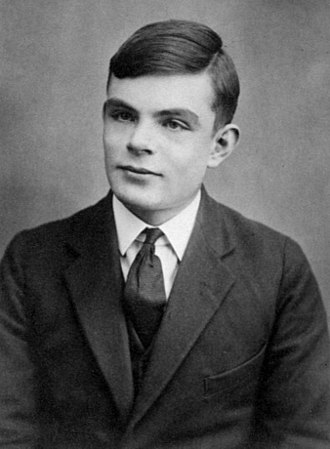
Famous computer scientist Alan MacTheeson Turing
the abstract device now known as the 'Turing machine' was capable of solving any mathematical problem imaginable in mathematical terms. [2]To this day, the Turing machine is a central topic in computational theory. Two years later, as the Second World War began, Alan was hired to break the code at Bletchley Manor because of his outstanding mathematical skills. Many people believe that his work brought the Allies victory in the Second World War two years earlier[3]. After the end of the Second World War, Alan's research gradually shifted to artificial intelligence, and his work over the years opened the door to artificial intelligence in the field of computing.[4] Automatic computers and stored program computers, meaning that programs stored in memory can run automatically, which is the basis of computers to achieve artificial intelligence[5]. He came up with what became known as the Turing Test, which marked the beginning of the theoretical basis for the science of artificial intelligence.[6] Alan's great legacy continues to evolve, to amaze, to excite, and to advance. Computers are also infiltrating every aspect of human life.[7] From wars to remote talks, from 4D movies to the development of MRI technology. His brilliance and fearlessness in the face of problems remained a benchmark for decades, inspiring generations of computing practitioners.[8]
Reference
[1] DUAN K, BAI S, XIE L, et al. CenterNet: Keypoint Triplets for Object Detection[C]//IEEE International Conference on Computer Vision. 2019: 6569-6578.
[2] REDMON J, DIVVALA S, GIRSHICK R, et al. You Only Look Once: Unified,Real-Time Object Detection[C]//IEEE Conference on Computer Vision and Pattern Recognition, 2016: 779-788.
[3] GRAVES A, WAYNE G, DANIHELKA I. Neural Turing Machines[J]. arXiv preprint arXiv, 2014:1410.5401.
[4] HINTON G, OSINDERO S, TEH Y. A Fast Learning Algorithm for Deep Belief Nets[J]. Neural computation, 2006, 18(7):1527-54.
[5] HINTON G, SALAKHUTDINOV R. Reducing the Dimensionality of Data with Neural Networks[J]. Science, 2006, 313(5786):504-7.
[6] CHEN Z, WANG J, HE H, et al. A Fast Deep Learning System Using GPU[C]//2014 IEEE International Symposium on Circuits and Systems, 2014 :1552-1555.
[7] ZHANG Y, ZHANG S. Optimized Deep Learning Architectures with Fast Matrix Operation Kernels on Parallel Platform[C]//2013 IEEE 25th International Conference on Tools with Artificial Intelligence, 2013:71-78.
[8] FARABET C, MARTINI B, AKSELROD P, et al. Hardware Accelerated Convolutional